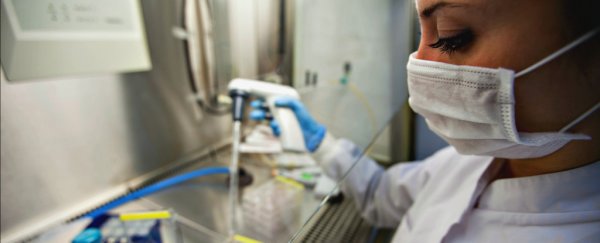A new HIV vaccine candidate has been trialled in humans and monkeys, with promising results.
Nearly 400 healthy, uninfected adults mounted an immune response against the vaccine and tolerated it well, according to the latest study. In monkeys, 67 percent were protected against the closely-related SHIV infection.
This is one of only five vaccines to have made it to this stage of testing in the 35 years since the HIV/ AIDS epidemic started. But before we get too excited, it needs to pass a crucial next step.
The vaccine will now be given to 2,600 at-risk women in Southern Africa in a Phase 2b trial to see if it can actually protect them from HIV infection.
Other options have failed to offer long-term protection in these types of real-world conditions.
That's because most previous attempts have been based on a HIV strain from a specific region of the world, and the virus is able to rapidly mutate, effectively making any vaccine attempts outdated before they've even been rolled out.
But this new vaccine takes a different approach. It's called a 'mosaic' vaccine because it contains pieces of different HIV viruses and combines them together to trigger an immune response against a wide variety of HIV strains.
We have no evidence so far that it will actually work in the field, so it's important to be cautious interpreting these early results.
But the researchers working on the vaccine from Harvard Medical School are cautiously pleased.
"These results represent an important milestone," said lead researcher Dan Barouch.
"The challenges in the development of an HIV vaccine are unprecedented, and the ability to induce HIV-specific immune responses does not necessarily indicate that a vaccine will protect humans from HIV infection. We eagerly await the results of the phase 2b efficacy trial."
With an estimated 1.8 million new cases of HIV every year, a safe and effective vaccine would be an incredible tool in stopping the pandemic.
Over the past 35 years, only one other vaccine has provided evidence of protection in an efficacy trial - the RV144 vaccine, which was trailed in Thailand and lowered the rate of human infection by 31 percent. That's good, but not enough to advance the vaccine into the market.
One of the biggest challenges is the fact that many vaccine candidates that seem to work in the lab or in animal trials often don't work in human trials, which means a lot of time and money can be spent developing something that doesn't actually work.
Instead, the Harvard team decided to test not just one, but seven of the leading mosaic vaccine regimen candidates at the same time, to identify the best combination to take to the next phase.
To do this, they recruited 393 healthy, HIV-uninfected adults (aged 18 to 50 years) between February and October 2015. The participants were treated in clinics in east Africa, South Africa, Thailand, and the USA, and either received a placebo or one of seven vaccine combinations.
They were given four vaccinations over the course of 48 weeks.
The results, which were published last week, showed that all the vaccine regimens generated an anti-HIV immune response, and were well tolerated.
The different groups all had similar rates of mild to moderate side effects, such as headache and fatigue. In five people, dizziness, diarrhoea and back pain were among the most severe symptoms.
At the same time, the same regimens were tested in 72 rhesus monkeys, who were then exposed to simian-human immunodeficiency virus (SHIV), which is very similar to HIV.
The most effective combination was called the Ad26/Ad26 plus gp140 vaccine candidate - it protected two-thirds of the vaccinated monkeys against infection.
Of course, there's no guarantee that will also happen in humans. But there are reasons to be optimistic.
"The road to the clinic is still unpredictable since the exact mode of action in humans is still unknown and the 67 percent protection in monkeys might not be replicable in humans," said George Williams Mbogo from the Burnet Institute in Australia, who wasn't involved in the study.
"The evidence gives strong optimism since previous attempts were elusive and it provides a new benchmark for future improvements," he added.
The results have been published in The Lancet.
